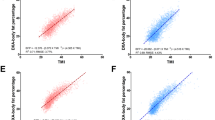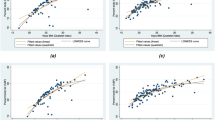Abstract
Objective:
To determine the impact of commonly used body fat percentage (%BF) references when evaluating the sensitivity, specificity and misclassifications of body mass index (BMI) for obesity screening in adolescence.
Subjects/Methods:
A community-based sample of 3334 adolescents aged 15.2±0.6 years was studied. Weight, height and %BF were measured. Sensitivity, specificity, predictive values and type and extent of misclassifications were calculated. True-positive subjects for overweight and obesity were defined by recently published paediatric %BF cutoffs, 85th and 95th percentiles from the present study population, and an older %BF reference.
Results:
Regardless of %BF reference used, specificities were high (>0.98 for obesity and >0.90 for overweight) in both sexes, with values for overweight consistently higher for girls (P<0.05). Sensitivities were much lower, with boys ranging from 0.52 to 0.74 for overweight, and 0.24 to 0.43 for obesity. Corresponding sensitivities for girls were 0.42–0.66 and 0.22–0.46. Large discrepancies were seen in total number of misclassifications, with published references resulting in twice as many misclassified for overweight (620, 514 vs 362) when compared to the cutoffs from the study population. For obesity, the difference was even greater (367 vs 133).
Conclusions:
No matter which %BF reference used, specificity of BMI was high, and sensitivity low for both sexes. Population percentiles resulted in somewhat lower specificity but much higher sensitivity, and many more correctly classified compared to when cutoffs from the literature were used. The choice of %BF reference in evaluations of BMI-based classification systems has a large impact on the outcome. Sensitivity analyses are therefore warranted.
This is a preview of subscription content, access via your institution
Access options
Subscribe to this journal
Receive 12 print issues and online access
$259.00 per year
only $21.58 per issue
Buy this article
- Purchase on Springer Link
- Instant access to full article PDF
Prices may be subject to local taxes which are calculated during checkout


Similar content being viewed by others
References
Cole TJ, Bellizzi MC, Flegal KM, Dietz WH (2000). Establishing a standard definition for child overweight and obesity worldwide: international survey. BMJ 320, 1240–1243.
Eriksson M, Rasmussen F, Nordqvist T (2005). Changes in shape and location of BMI distributions of Swedish children. Acta Paediatr 94, 1558–1565.
Fu WP, Lee HC, Ng CJ, Tay YK, Kau CY, Seow CJ et al. (2003). Screening for childhood obesity: international vs population-specific definitions. Which is more appropriate? Int J Obes Relat Metab Disord 27, 1121–1126.
Goran MI (1998). Measurement issues related to studies of childhood obesity: assessment of body composition, body fat distribution, physical activity, and food intake. Pediatrics 101 (3 Part 2), 505–518.
Guillaume M (1999). Defining obesity in childhood: current practice. Am J Clin Nutr 70, 126S–130S.
Houtkooper LB, Going SB, Lohman TG, Roche AF, Van Loan M (1992). Bioelectrical impedance estimation of fat-free body mass in children and youth: a cross-validation study. J Appl Physiol 72, 366–373.
Kuczmarski RJ, Ogden CL, Grummer-Strawn LM, Flegal KM, Guo SS, Wei R et al. (2000). CDC growth charts: United States. Adv Data 314, 1–27.
Kyle UG, Bosaeus I, De Lorenzo AD, Deurenberg P, Elia M, Gomez JM et al. (2004). Bioelectrical impedance analysis—part I: review of principles and methods. Clin Nutr 23, 1226–1243.
Lazarus R, Baur L, Webb K, Blyth F (1996). Body mass index in screening for adiposity in children and adolescents: systematic evaluation using receiver operating characteristic curves. Am J Clin Nutr 63, 500–506.
McCarthy HD, Cole TJ, Fry T, Jebb SA, Prentice AM (2006). Body fat reference curves for children. Int J Obes (Lond) 30, 598–602.
Neovius M, Linne Y, Rossner S (2005). BMI, waist-circumference and waist-hip-ratio as diagnostic tests for fatness in adolescents. Int J Obes Relat Metab Disord 29, 163–169.
Neovius MG, Linne YM, Barkeling B, Rossner S (2004). Sensitivity and specificity of classification systems for fatness in adolescents. Am J Clin Nutr 80, 597–603.
Rasmussen F, Eriksson M, Bokedal C, Schäfer-Elinder L (2004). Physical activity, eating habits, overweight and self-esteem among youth. COMPASS—a study in south-west Greater Stockholm. Center of Public Health, Stockholm County Council and National Institute of Public Health. Report 2004:1 (In Swedish).
Rasmussen F, Eriksson M, Nordqvist T (2007). Bias in height and weight reported by Swedish adolescents and relations to body dissatisfaction: the COMPASS study. Eur J Clin Nutr 61, 870–876.
Reilly JJ, Dorosty AR, Emmett PM (2000). Identification of the obese child: adequacy of the body mass index for clinical practice and epidemiology. Int J Obes Relat Metab Disord 24, 1623–1627.
Reilly JJ, Wilson J, Durnin JV (1995). Determination of body composition from skinfold thickness: a validation study. Arch Dis Child 73, 305–310.
Sardinha LB, Going SB, Teixeira PJ, Lohman TG (1999). Receiver operating characteristic analysis of body mass index, triceps skinfold thickness, and arm girth for obesity screening in children and adolescents. Am J Clin Nutr 70, 1090–1095.
Williams DP, Going SB, Lohman TG, Harsha DW, Srinivasan SR, Webber LS et al. (1992). Body fatness and risk for elevated blood pressure, total cholesterol, and serum lipoprotein ratios in children and adolescents. Am J Public Health 82, 358–363.
Zimmermann MB, Gubeli C, Puntener C, Molinari L (2004). Detection of overweight and obesity in a national sample of 6–12-y-old Swiss children: accuracy and validity of reference values for body mass index from the US Centers for Disease Control and Prevention and the International Obesity Task Force. Am J Clin Nutr 79, 838–843.
Zweig MH, Campbell G (1993). Receiver-operating characteristic (ROC) plots: a fundamental evaluation tool in clinical medicine. Clin Chem 39, 561–577.
Acknowledgements
MN was funded by Arbetsmarknadens Forsakrings-och Aktiebolag (AFA).
Author information
Authors and Affiliations
Corresponding author
Rights and permissions
About this article
Cite this article
Neovius, M., Rasmussen, F. Evaluation of BMI-based classification of adolescent overweight and obesity: choice of percentage body fat cutoffs exerts a large influence. The COMPASS study. Eur J Clin Nutr 62, 1201–1207 (2008). https://doi.org/10.1038/sj.ejcn.1602846
Received:
Revised:
Accepted:
Published:
Issue Date:
DOI: https://doi.org/10.1038/sj.ejcn.1602846
Keywords
This article is cited by
-
The triponderal mass index as a measure of adiposity in pediatric survivors of acute lymphoblastic leukemia: a cross-sectional study
Scientific Reports (2022)
-
The Tri-ponderal Mass Index is associated with adiposity in adolescent type 2 diabetes mellitus: a cross-sectional analysis
Scientific Reports (2021)
-
High blood pressure and its relationship to adiposity in a school-aged population: body mass index vs waist circumference
Hypertension Research (2018)
-
Effect of four additional physical education lessons on body composition in children aged 8–13 years – a prospective study during two school years
BMC Pediatrics (2013)
-
BMI percentiles for the identification of abdominal obesity and metabolic risk in children and adolescents: evidence in support of the CDC 95th percentile
European Journal of Clinical Nutrition (2013)



